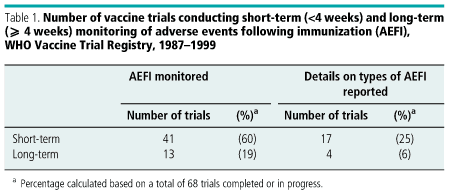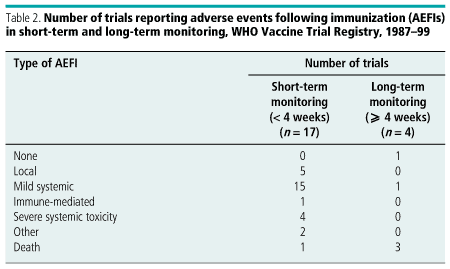BULLETIN 2000 FEEDBACK
Adverse events monitoring as a routine component of vaccine clinical trials: evidence from the WHO Vaccine Trial Registry
Marti Vall MayansI;Susan E. RobertsonII; Philippe DuclosII
IClinical Epidemiologist, Directorate of Primary Health Care, Catalan Health Institute, Barcelona, Spain
IIMedical Officer, Department of Vaccines and Biologicals, World Health Organization,1211 Geneva 27, Switzerland
The February 2000 Bulletin Round Table Discussion on vaccine adverse events includes a commentary by Clemens on evaluation of vaccine safety before and after licensure (1). Clemens emphasizes that sample sizes in Phase 13 vaccine clinical trials are generally too small to assess the potential of vaccines to produce rare side-effects. Another problem in evaluating adverse events in clinical trials is that the population studied is usually healthy and thus may differ from the population routinely administered the vaccine following licensure (2). Nevertheless, Phase 1 and 2 vaccine trials have as their primary objective the short-term evaluation of vaccine safety, while Phase 3 and 4 trials offer the potential for both short-term and long-term safety assessments.
The WHO Immunization Safety Priority Project has set an objective of ensuring that safety is appreciated as a principal endpoint in vaccine clinical trials (3). For trials on pharmaceutical products, including vaccines, safety monitoring is a key requirement of Good Clinical Practice (GCP) guidelines (4). We used the WHO Vaccine Trial Registry to assess whether and how investigators are monitoring adverse events following immunization (AEFIs) in vaccine trials.
The Vaccine Trial Registry includes all vaccine trials sponsored since 1987 by WHOs Expanded Programme on Immunization, Global Programme for Vaccines and Immunization, and Department of Vaccines and Biologicals (5, 6). For each trial, records include internal documents, reports of visits to trial sites, and publications. As of August 1999, the Registry included 68 trials completed or in progress. The trials concerned vaccines against a wide spectrum of infectious agents and diseases, including cholera, dengue, enterotoxigenic Escherichia coli, hepatitis B, Haemophilus influenzae type B, measles virus, meningoccocus, pneumococcus, poliovirus, tetanus, tuberculosis, and typhoid.
Based on GCP guidelines, an AEFI was defined as an untoward medical occurrence in a clinical trial subject administered a vaccine; it does not necessarily have a causal relationship with the vaccination (4). Vaccine Trial Registry records were reviewed to assess (a) whether AEFIs were mentioned; (b) whether AEFI monitoring was short-term (< 4 weeks) or long-term (> 4 weeks); and (c) types of AEFIs monitored. AEFIs were classified as local, mild systemic (fever, nausea, malaise, headache), immune-mediated (anaphylaxis), severe systemic toxicity (or other symptoms requiring hospitalization), other (persistent screaming, etc.), death, and not stated.
AEFIs were mentioned in reports from 48 (71%) of the 68 vaccine clinical trials initiated during 198799 (Fig. 1). The tendency to report AEFIs increased significantly (P = 0.01) over time: 54% (14/26) of trials started in 198793 mentioned AEFIs, compared with 81% (34/42) of trials started in 199499. AEFIs were mentioned in 100% of Phase 12, 69% of Phase 3, and 42% of Phase 4 vaccine trials (P< 0.001).
Forty-one (60%) of the 68 trials conducted short-term AEFI monitoring, but only 17 (25%) detailed the types of events monitored; 13 (19%) trials continued monitoring on a long-term basis (> 4 weeks), but details were reported for only 4 (6%) (Table 1). The type of adverse events most commonly monitored was mild systemic (Table 2).


The increasing trend to include AEFI monitoring in vaccine clinical trials is reassuring, but our analysis indicates that few investigators included detailed AEFI monitoring in their study reports and publications. Ward suggests that ensuring AEFI monitoring in vaccine trials is the responsibility of the vaccine manufacturer and the national control authority (7). However, many vaccine trials are conducted by independent investigators employed by governmental or academic institutions. We believe that study design and public reporting of AEFI monitoring is the responsibility of the study investigators, and that AEFI monitoring methods and results deserve to be included in any publication, along with vaccine efficacy methods and results. Journal editors and reviewers need to be aware that AEFI data, even when negative, are essential information in vaccine trial publications.
We propose the following practical points for monitoring AEFIs in vaccine clinical trials.
Use of the following standard definition: An adverse event following immunization (AEFI) is an untoward medical occurrence in a clinical trial subject administered a vaccine; it does not necessarily have a causal relationship with the vaccination.
AEFI monitoring should be short-term (< 4 weeks) in all vaccine trials and long-term (> 4 weeks) in Phase 3 and 4 trials whenever possible.
Trial publications should report the types of AEFIs monitored, using standard definitions, so that results of different trials will be comparable. A WHO list of AEFI definitions (8) is available, but needs to be updated in light of new vaccine developments. The absence of AEFIs should also be reported, as this information will contribute to the comprehensive information available for vaccines.
Where AEFIs are monitored, causality assessment should be carried out for suspected adverse events, using standard WHO criteria which classify causality as: very likely/certain, probable, possible, unlikely, unrelated, and unclassifiable (9). Causality assessment needs to be carried out by an advisory committee independent of the trial investigators. 
1. Clemens J. Evaluating vaccine safety before and after licensure. Bulletin of the World Health Organization, 2000, 78: 218219.
2. Monitoring and assessment of adverse drug effects: CIOMS Working Group report. Geneva, Council for International Organizations of Medical Sciences (CIOMS), 1986.
3. Report of the first meeting of the Steering Committee on Immunization Safety, Geneva, 2526 October 1999. Geneva, World Health Organization, 2000 (unpublished document WHO/V&B/00.17, available from the Department of Vaccines and Biologicals).
4. Guidelines for good clinical practice (GCP) for trials on pharmaceutical products. In: The use of essential drugs. Sixth report of the WHO Expert Committee. Geneva, World Health Organization, 1995 (WHO Technical Report Series, No. 850, Annex 3: 97137).
5. Vaccine Trial Registry directory. Geneva, World Health Organization, 2000 (unpublished document WHO/V&B/00.07, available from the Department of Vaccines and Biologicals).
6. Robertson SE et al. The WHO Global Programme for Vaccines and Immunization Vaccine Trial Registry. Bulletin of the World Health Organization, 1997, 75: 295305.
7. Ward BJ. Vaccine adverse events in the new millennium: is there reason for concern? Bulletin of the World Health Organization, 2000, 78: 205215.
8. Surveillance of adverse events following immunization: field guide for managers of immunization programmes. Geneva, World Health Organization, 1993 (unpublished document WHO/EPI/TRAM/93.02 Rev.1, available from the Department of Vaccines and Biologicals).
9. Collet JP et al. Monitoring signals for vaccine safety: the assessment of individual adverse event reports by an expert advisory committee. Bulletin of the World Health Organization, 2000, 78: 178185.
Correspondence
Susan E. Robertson
Department of Vaccines and Biologicals, World Health Organization
1211 Geneva 27, Switzerland
E-mail: robertsons@who.int
